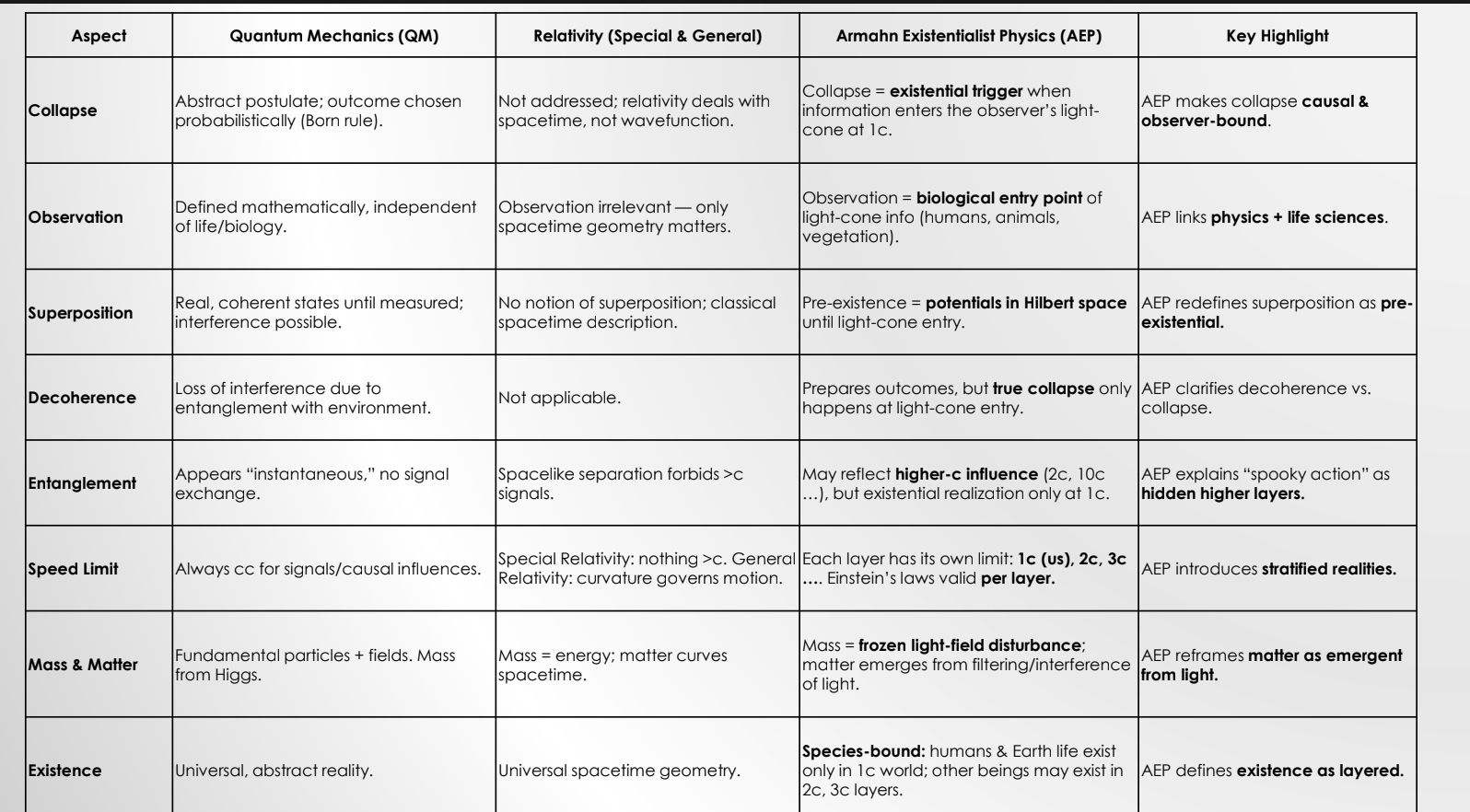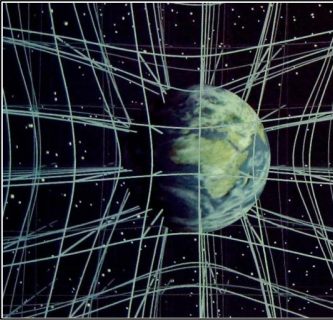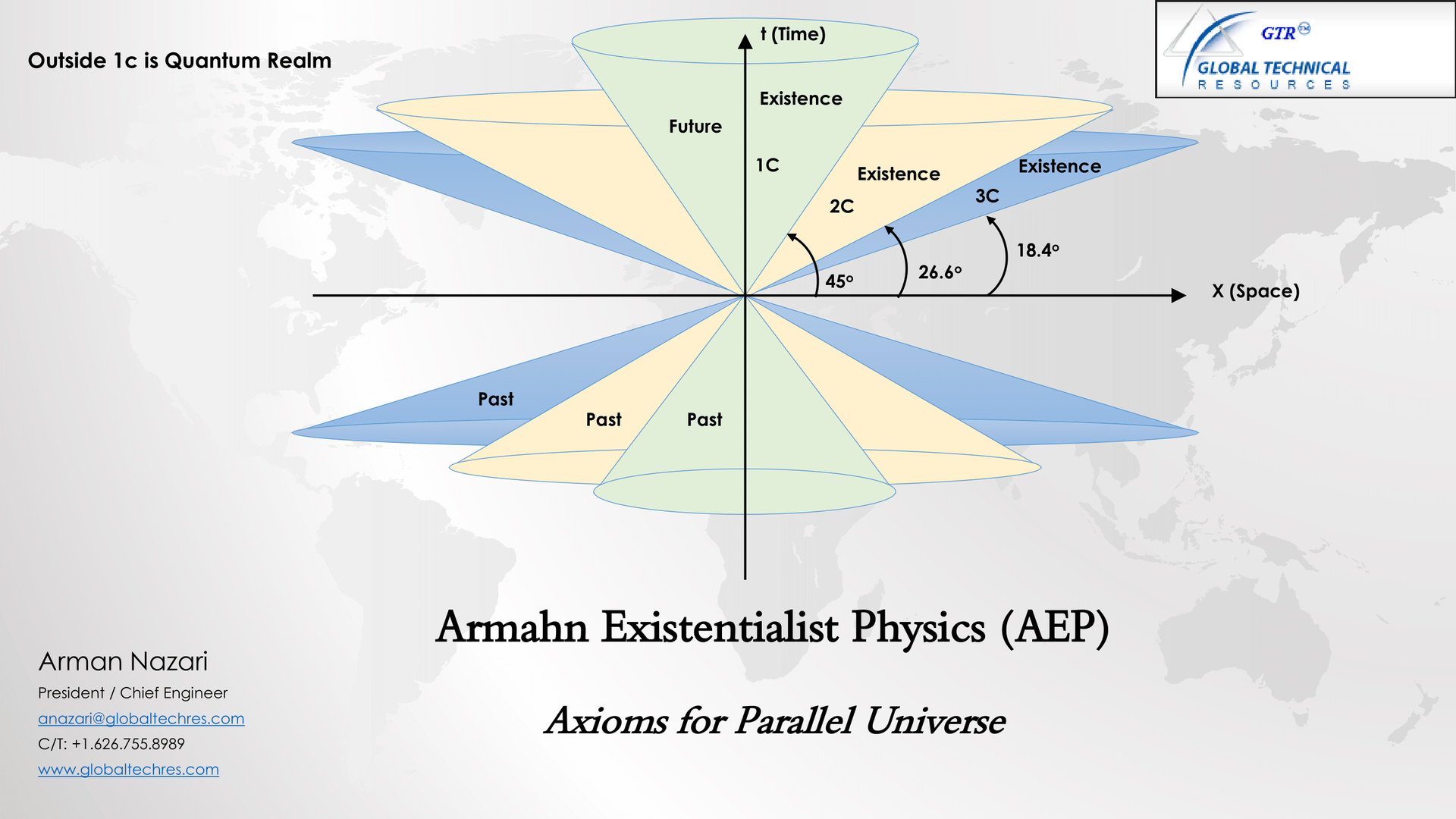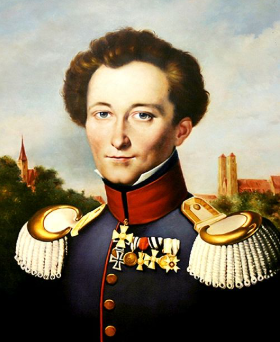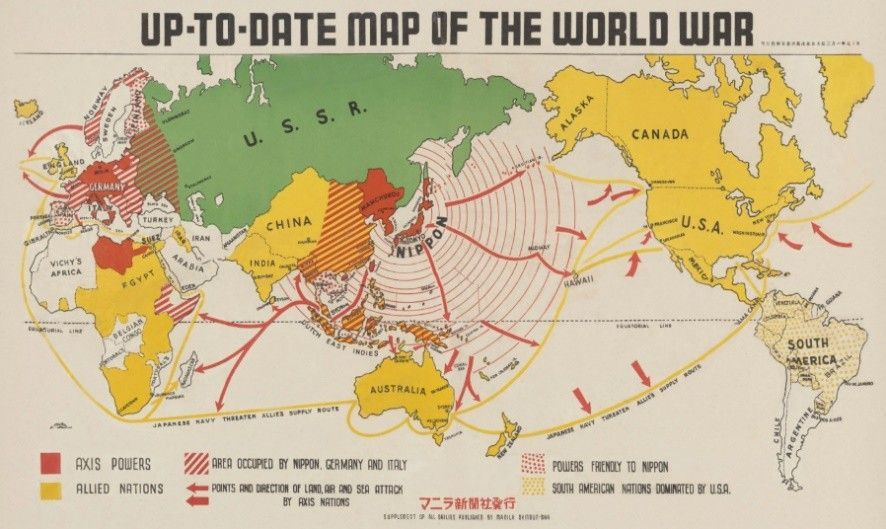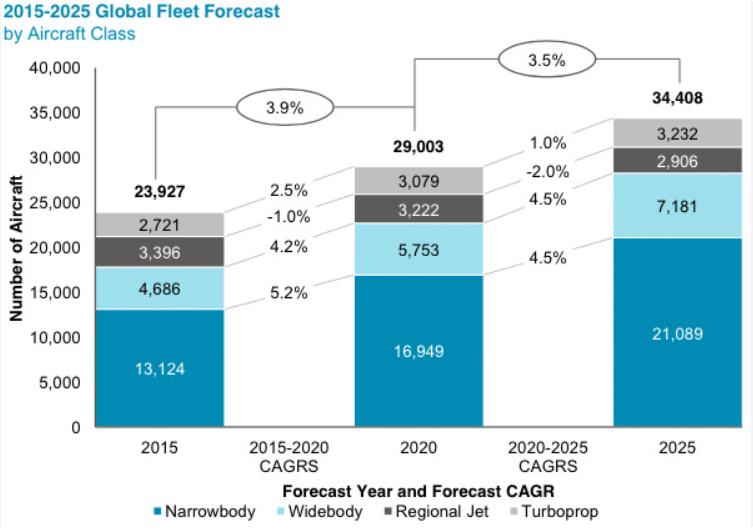ARTICLES
Follow Us
Be the first to know
Armahn Existentialist Physics (AEP)- Axioms for Light-Cone Bound Existence
By:
Arman M Nazari
President,
Global Technical Resources | Aerospace & Defense SME
Abstract
Quantum mechanics describes microscopic systems with remarkable precision, yet its measurement problem
remains unresolved. Relativity constrains information to propagate at or below the speed of light (c) but offers
no account of how quantum indeterminacy becomes existential reality for living beings.
This paper introduces Armahn Existentialist Physics (AEP): a speculative framework postulating that existence
for humans, animals, and vegetation is bound to information transfer at the speed of light (c).
In AEP, quantum states are only realized existentially when their information enters the observer’s light-cone.
Higher-order existential layers (2c, 3c, ...) are hypothesized, suggesting that what appears instantaneous or
“spooky” in our 1c world may be causal in higher-c worlds.
1. Introduction
Einstein’s relativity successfully describes causality for all observed physical processes in the 1c world.
Quantum mechanics, however, raises deep questions: why does a particle appear in a definite state only
when observed?
The present work introduces an alternative interpretation — existence is not universal but bound to the
observer’s existential layer defined by light-cone speed. For humans and known biology, this layer is 1c.
AEP postulates higher-c layers where other species or civilizations could exist, each governed by its own relativity.
2. Axioms of Armahn Existentialist Physics
Axiom 1 (Existential Bound):
For humans, animals, and vegetation, existence is realized only when information about a system propagates into the
observer’s light-cone at the speed of light (c).
Axiom 2 (Pre-Existence):
Quantum states outside the observer’s light-cone exist only as pre-existential potentials — superpositions in Hilbert space.
Axiom 3 (Collapse Trigger):
Collapse into a definite outcome occurs when information enters the light-cone. For us, this happens at 1c.
Axiom 4 (Amplification):
The rate of existential collapse depends on the intensity of information flux (e.g., number of photons,
redundancy of records).
Axiom 5
(Existential Stratification):
Existence is layered. 1c defines our species’ reality. Hypothetical 2c or 3c species would experience their own relativistic physics with wider light-cones, perceiving as causal what appears instantaneous to us.
Axiom 6 (Material Existence):
Material mass and the creation of matter arise from differential light-speed disturbances within the light field
tensor.
• Matter as interference: Matter forms when regions of the field filter, absorb, or interfere with light, preventing smooth propagation at ccc.
• Tensor disturbance: These interactions disturb the underlying light field tensor, creating localized, persistent structures that we recognize as mass.
• Bidirectional relation:
• Matter modifies the flow of light (through scattering, filtering, and absorption).
• Light, in turn, stabilizes and defines matter by shaping the tensor disturbance.
• Interpretation: Mass is not fundamental “stuff,” but an emergent property — frozen light-field disturbance within the 1c existence layer.
3. Comparisons to Established Physics
3.1 Standard Quantum Mechanics
- QM View: Collapse is abstract, observer-independent, and not tied to relativity.
- AEP View: Collapse is observer-relative and bound by light-cone causality at 1c.
3.2 Decoherence
- Standard View: Interference disappears when system entangles with its environment.
- AEP View: Decoherence prepares potential outcomes, but existential collapse occurs only upon light-cone entry.
3.3 Entanglement
- Standard View: Entanglement correlations are instantaneous but carry no signal.
AEP View: Entanglement may reflect higher-c information flow. We perceive it as “instantaneous” because the underlying causal link is hidden beyond 1c.
4. Implications of AEP
1. Einstein’s Relativity is Layer-Specific.
• All of relativity holds perfectly in the 1c world.
• Higher-c species would experience their own relativities.
2. Multi-Civilization Ontology.
• Humanity exists in the 1c layer.
• Other forms of life may exist at 2c, 3c, or higher.
• For them, superluminal travel would not break physics — it would be natural.
3. Warp Travel Reinterpreted.
• Faster-than-light travel is not breaking relativity but transitioning between existential layers.
• A “warp” is a shift in existential binding, not a violation of Einstein’s laws.
4. Quantum Measurement Redefined.
• What we call “observation” is the moment a system’s information becomes available to our biological light-cone filter.
5. Experimental Pathways
AEP is speculative, but testable principles exist:
1. Delayed Record Test: Collapse should be perceived only when the record enters the observer’s light-cone
(using fiber delay with interferometers).
2. Amplification Test: Stronger photon flux → faster collapse for the observer.
3. Entanglement Bounds: Use long-distance entanglement (Earth-satellite, lunar) to set lower bounds on hidden
higher-c speeds.
4. Observer-Relative Test: Different observers at different distances should perceive collapse at different times.
6. Conclusion
AEP proposes that existence is not universal, but species-bound to light-cone causality at c. For humans,
animals, and vegetation, this defines our 1c world. Entanglement and quantum collapse are reinterpreted
as evidence of deeper higher-c layers, where Einstein’s relativity continues to hold but with new speed
limits.
If correct, AEP reframes both the measurement problem and the possibility of faster-than-light travel. For
us, c remains absolute. For other species or higher layers, 2c, 3c, or even ∞c may be equally real.
AEP and the Philosophy of Existence
Key Idea:
• Standard physics treats collapse as an abstract calculation.
• AEP reframes collapse as existential, bound to species, biology, and the light-cone
at ccc.
Impact:
• Existence is not absolute; it is observer- and species-bound.
• For humans, animals, and vegetation: reality is filtered through 1c.
• This challenges the classical notion of a single, universal reality.
Stratified Realities (1c, 2c, 3c ...)
Key Idea:
• AEP introduces the possibility of multiple existential layers, each with its own
relativistic structure.
Impact:
• Relativity remains valid in every layer — but only for that layer’s beings.
• Humanity is confined to the 1c stratum.
• Other forms of life may exist in higher-c strata (2c, 3c), with broader access to
reality.
Redefining “Observation”
Key Idea:
• In standard QM, observation is a mysterious abstraction.
• In AEP, observation = entry of information into the biological light-cone.
Impact:
• Observation is not just physics, but bio- physics.
• It links physics to consciousness, perception, and life processes.
• Philosophy of mind: existence and awareness are deeply intertwined.
Human Condition in AEP
Key Idea:
• Our species experiences reality through the 1c filter.
• The “instantaneous” or “spooky” aspects of entanglement may be natural in higher-c
worlds.
Impact:
• Reinforces human limitations and humility in the cosmos.
• Suggests a broader ontology where our reality is only one layer among many.
• Opens dialogue between physics, metaphysics, and even theology:
• What does it mean for existence to be layered?
• Could “higher-c worlds” explain mystical or transcendent experiences?
Matter as Disturbed Light
Key Idea:
• In AEP, mass is not fundamental.
• It emerges when light is filtered, interfered with, or stopped within the existential layer.
Impact:
• Matter is a process, not a substance.
• Challenges materialist philosophy: what we call “stuff” is really frozen patterns in the light field.
Tensor Disturbance as Creation
Key Idea:
• The light field tensor underlies existence.
• Disturbances in this tensor generate persistent structures — what we call particles and materials.
Impact:
• Creation is redefined: not “something from nothing,” but stability arising from field disturbance.
• Links physics to metaphysical traditions where reality is seen as vibration, wave, or resonance.
Bidirectional Relation of Light and Matter
Key Idea:
• Matter shapes light (scattering, filtering).
• Light shapes matter (stabilizing tensor disturbances).
Impact:
• Existence is not one-way but mutual.
• Philosophical shift: reality is a dialogue between light and matter, not
dominance of one over the other
Frozen Light as Ontology
Key Idea:
• Mass can be interpreted as frozen light-field disturbance.
• Material existence is a slowed, stabilized form of light.
Impact:
• Bridges physics and ontology: matter is a mode of light.
• Philosophical resonance with ideas from Plato (shadows/forms), to Eastern traditions (maya/illusion
of matter).
• AEP reframes “what is real” as layered, dynamic, and light-bound.
Philosophical Shifts with AEP
• Reality is relativized by existence-layer.
• Collapse is existential, not abstract.
• Human knowledge is bounded by 1c biology.
• Other civilizations may inhabit faster existential layers.
• AEP bridges physics, metaphysics, and philosophy of mind.
Explanations
1. Potentials
In quantum physics, a particle before observation does not exist in a single definite state. Instead, it has
potentials — different possibilities for how it could appear if measured. For example, an electron passing
through two slits is not definitely in the left or the right slit. It has the potential to be found in either. These
potentials are real in the mathematical description, even if they are not yet realized for us.
2. Superpositions
A superposition means that more than one potential is combined together at the same time. In simple terms, the
particle is in multiple possible states until observation forces one outcome. If a particle can be spin-up or spin-down,
before measurement it exists in a mixture of both:
∣ψ⟩=α∣up⟩+β∣down⟩
This mathematical expression says the particle is in a weighted blend of the two states, not exclusively one or the other.
3. Hilbert Space
A Hilbert space is the mathematical “arena” where all possible states of a system exist. Every potential state
(position, spin, energy level, etc.) is like a direction in this space. A particle’s actual condition is represented as
a vector pointing through these directions. When we say “a superposition in Hilbert space,” it means the
particle’s state is a combination of several possibilities, described geometrically in this abstract space.
4. Putting It Together
Before observation, a particle exists in potentials — a range of possibilities. These possibilities combine into
superpositions, which are represented mathematically as vectors in Hilbert space. Only when information about
the system enters our light-cone (in AEP terms) does one of those potentials become realized as existence for
humans, animals, and vegetation. In other words: the particle is “spread out” in mathematical space until the act of
observation writes it into our reality.
Why Quantum Collapse is Abstract
In standard quantum mechanics, the collapse of the wavefunction is not a physical process we can describe with equations of
motion. Instead, it is introduced as a postulate — a rule we apply when a measurement is made.
• Before measurement: the system evolves smoothly and predictably according to the Schrödinger equation. This is
deterministic and continuous.
• At measurement: the system is suddenly said to “collapse” into one outcome, chosen randomly but weighted by
probabilities (the Born rule). This is not explained by the Schrödinger equation itself.
Because collapse is not described by any physical mechanism in mainstream theory, it is treated as an abstract step:
• It does not tell us how or why the collapse happens.
• It only tells us what we should update in our calculations once we look.
• In other words, collapse is more like an instruction for observers than a law of nature.
This abstract nature is why the measurement problem exists. Physicists argue over whether collapse is:
• A real physical process (objective collapse theories).
• An illusion caused by decoherence (environment hiding interference).
• Or simply a reflection of our limited knowledge (many-worlds, relational interpretations).
AEP makes collapse concrete:
it is not abstract but tied directly to light-cone entry at 1c for humans,
animals, and vegetation.
That’s the innovation — AEP replace an abstract postulate with a causal, physical trigger.
1. What does “coherent” mean in quantum mechanics?
• Coherence is when the different parts of a quantum superposition maintain a stable phase relationship.
• That stable phase is what allows interference patterns to appear (like in the double-slit experiment).
Example:
• A laser beam is called coherent light because all its photons are in phase with each other, so they can
interfere constructively or destructively in a very regular way.
• In quantum mechanics, a superposition like
• ∣ψ⟩=α∣left⟩+β∣right⟩
is coherent if the two components (left, right) can still interfere — meaning the “wave parts” overlap and form
fringes.
Decoherence happens when the environment randomizes or scrambles that phase information. Once the coherence
is gone, interference patterns vanish, and the system looks like a classical mixture instead of a true quantum
superposition.
2. About your electron and the slits
Q: “If I look at the electron on one slit and it collapses to a particle, does the other superposition through the other slit
collapse as well?”
Yes — exactly. Here’s why:
• Before you measure, the electron is in a coherent superposition of going through both slits.
• The moment you measure which slit it went through, you perform a which-path measurement.
• That act of measurement forces the wavefunction to collapse into one outcome:
• “Electron went through slit A” or
• “Electron went through slit B.”
When collapse happens, the other possibility is eliminated — the full superposition (both paths) is destroyed.
This is why, when you look at the slits, the interference pattern disappears: you’ve broken the coherence.
All that’s left are classical “particle-like” outcomes (spots on the screen behind one slit).
What is Decoherence?
In quantum mechanics, particles can exist in superpositions (means Supra Position) - combinations of different possible states. For example, an
electron can be in a superposition of “left path” and “right path” at the same time.
Decoherence is the process by which those superpositions lose their ability to interfere, because the system becomes entangled with its environment.
• How it happens:
Every quantum system interacts with its surroundings — air molecules, photons, vibrations, detectors, even stray fields. These
interactions “leak” information about the system into the environment.
• Effect:
The environment effectively “measures” the system, even if no human observer is watching. As a result, the superposition spreads into
so many environmental degrees of freedom that the original interference pattern disappears.
• Example:
In the double-slit experiment, if even one stray photon scatters off the particle and into the environment, the interference fringes are
destroyed. The system no longer looks like a wave, but like a particle taking one path.
• Key point:
Decoherence does not choose one outcome. It only makes the system behave as if collapse has already happened by erasing
interference. The system still exists as a mathematical mixture of possibilities.
In AEP terms: Decoherence sets the stage by preparing potential outcomes. But the true
existential collapse (choosing one outcome for humans, animals, vegetation) happens only
when the information enters the observer’s light-cone at 1c.

